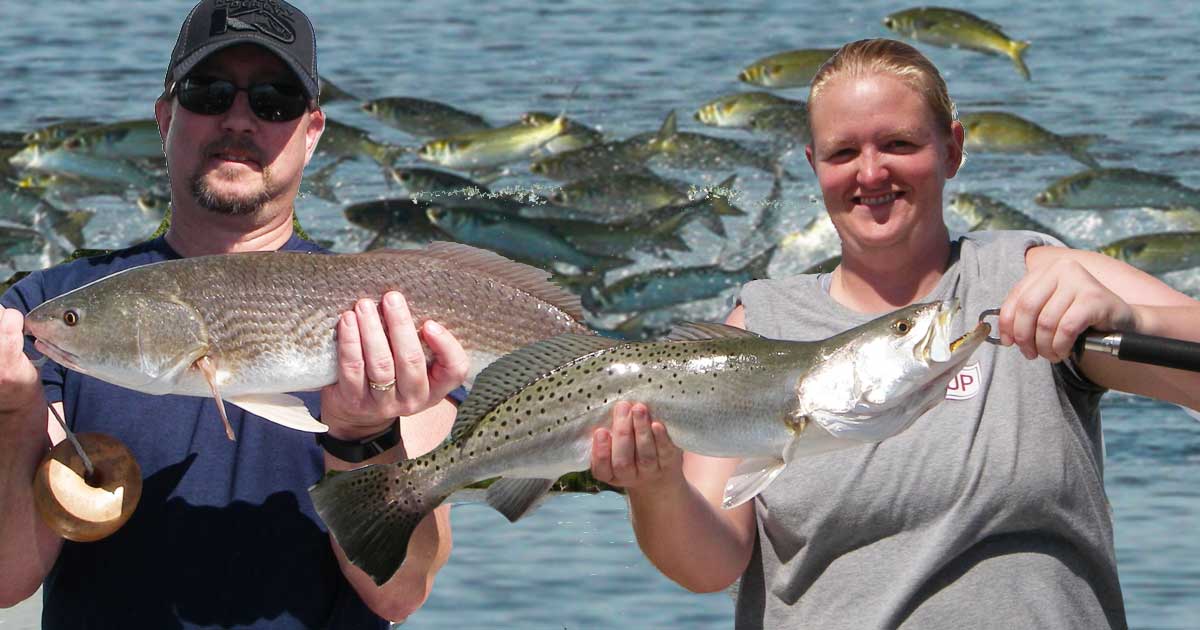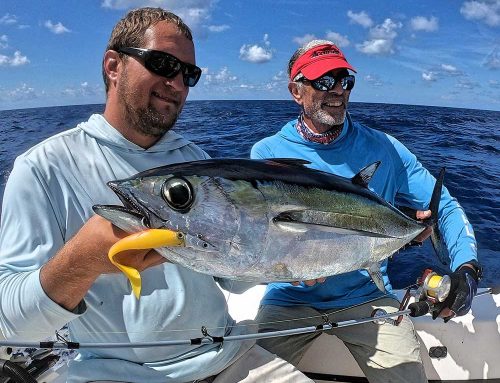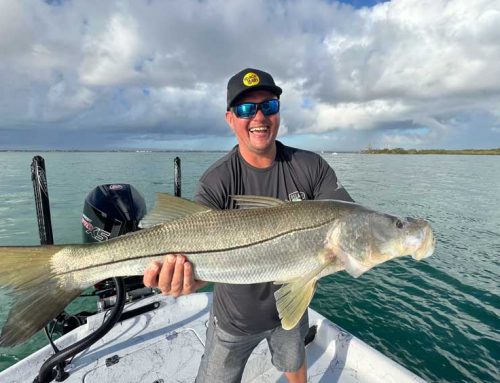
Just mentioning the term “fall mullet run” sends a shiver of excitement within the fishing communities of Florida’s coastal regions! There is no surprise as to why; all gamefish and rough fish like sharks that rely on mullet as a seasonal source of food flock to beaches to binge-feed on these creatures.
Florida’s Annual Fall Mullet Run
The true “mullet run” is the actual migration of mature mullet leaving the estuaries they grew up in and migrating to the ocean to live out their remaining years. On the Atlantic coast, the basic migratory direction is south, though they occasionally move back and forth a bit if weather or other natural issues arise.
In Florida, the first of the migration can take place in August, though September and October is considered prime time. Certainly shorter days, cooling water temps and rising water levels of the Fall season play their part in when the migration actually starts. However, I do think there are other less obvious elements within nature that play a role in the timing of the migration that are too subtle for us to notice, but is obvious to the mullet themselves!
The running baitfish, Mugil curema, are known locally as silver mullet and called white mullet or fantail mullet in other locales. These fish reach roughly twelve inches in length at maturity and are much smaller than their relative the black mullet.
Like many fish, they spawn in the ocean near inlets and their fertilized eggs or recently hatched embryos are carried into coastal estuaries with the tides. They’re two year growth cycle begins in the backwaters of the estuaries and eventually leave the extremely shallow backwaters and move, often en masse to the open waters of the Lagoon.
Once the short movement from backwater to open water takes place during the spring season, people begin the talk of the coming mullet run. In fact, the fall mullet run is a long ways off. The silver mullet at this time is in a “fingerling” size of roughly four inches in length. While they’re now mostly in open waters they still tend to stay relatively shallow often hugging close to islands, shorelines or schooling on shallow flats.
Feeding mostly on mud picked up from soft bottoms, their digestive system extracts nutrition from ingested detritus as well as any plankton or tiny critters that were inadvertently caught. Their gizzard reduces coarse material into a digestible state, giving the lowly mullet the nickname “chicken of the sea.” Mullet often filter feed on plankton and algae throughout the water column, and while we typically think of them as vegetarians, they truly are omnivorous.
There are most always juveniles far too small to leave the shallow backwaters and others which are nearly large enough to make the move. These might be fish that have grown more slowly and still require the safety of the backwaters; or more likely, they are the product of last year’s spawn. In many species of fish, it’s typical to have an early spawn or two giving in to the main spawning periods then the Johnny-come-latelies… All it means to us is the impending mullet run spreads out over a longer time frame than if they all spawned at once!
As the mullet continuing growing within the lagoon system through the spring and summer seasons, the prudent angler will take advantage of their presence. The fact that all of our inshore predators are targeting them is obvious, as the common scene of surface striking seatrout, redfish, jack crevalle and other predators is hard to miss.
Mullet Run Lure Selection
Often, the size of the predator dictates the size of the mullet being targeted. Breeder sized redfish seldom seek out three inch fingerling mullet unless that’s all there is to choose from. However, as the five to ten inch mullet become available, you can bet these trophy fish will hunt them down.
Similarly, our lure selection is dictated by the size of our quarry and the size of the mullet they are targeting. Three and four inch swim baits with either shad tails, ribbon tails or in a jerk shad form are my personal choices. I use Z-Man soft plastics and their outstanding line of hooks and jigheads to achieve a “match the hatch” imitation of the smaller early season mullet, then choose their larger five inch, six inch and seven inch versions as the mullet grow.
When in doubt of the proper size of a lure, I typically choose to go smaller first as I feel a smaller lure looks less artificial, at least in the water, than a larger option. If smaller doesn’t do the job, we can always go larger and hopefully find success.
This same basic premise applies to hard lures, too; whether we’re talking top-water plugs, sinking and suspending lures or spoons.
While I think it’s pretty obvious, it still bears saying here: live mullet and cut mullet are fantastic options when fishing near schooling mullet. Whether you buy yours from the local bait and tackle store or net your own, they’ll catch plenty of fish. Best of all they are simple to rig and the hook, leader and weight needed (or not needed) is as basic as fishing gets.
Outfits and Rigging Up
I use the same class of rod/reel/line outfits for lure and natural bait fishing. My basic light rigs are seven foot light tipped rods married to 2500 series spinning reels and loaded with eight pound braided line. This is my choice when tossing three and four inch lures that are lightly weighted.
My medium rods are a bit stiffer and stronger than the light rigs but still maintain a fairly soft tip. They’re married to either 2500 or 3000 sized spinning reels and loaded with ten pound braided line. These work well with heavier weighted four to five inch lures, and are my favorite for live fingerling mullet or cut mullet chunks.
The heavy rigs are still seven foot rods that step up in tip stiffness and power and sport 4000 sized reels and loaded with twenty pound braided line. I grab these when the big lures or larger live silver mullet come into play. If breeder sized redfish or black drum are our targets or if were fishing structure like dock pilings or bridges a “bigger stick” is a must!
The eight and ten pound mainlines connect to twenty pound fluorocarbon leaders via an FG knot. The twenty pound outfits are coupled to thirty or forty pound leader also with an FG knot. If you don’t know how to tie the FG, it is well worth learning as this knot effortlessly passes through the tiniest of today’s micro- guides and allows for a very long leader.
I tend to tie the leader to most lures with a generic loop knot. When using natural bait whether live or dead we tie the leader tight to the circle hook with a four wrap Uni-knot. I think it helps prevent the hook from turning back into the bait a second time, preventing an actual hook-up. Match your hook size to the baitfish. Most of the time a 3/0 inline circle works perfectly and moving up to a 5/0 circle is appropriate for a silver mullet of eight inches or more.
Weighting your live mullet is only necessary if you want it on or near the bottom. The amount of weight is dictated by factors like whether you’re anchored or drifting and the speed of your drift or current movement. Use only enough to get the job done and if you’re using an egg sinker I much prefer rigging it “knocker” style rather than the “fish finder” rig. The knocker casts better and helps to keep the bait down.
Finding the Mullet
One must decide which of the myriad mullet schools to fish near. Whether you’re within the lagoon or on the beaches it’s pretty much the same. I tend to pass by the smaller or more scattered groups of mullet and select a huge school of tightly packed together fish. If the predators happen to be blasting away at them, so much the better!
Unless there’s a lot of surface feeding from predators, I tend to offer my lures or free-lined mullet at the edges of the mullet school’s first and only toss my offerings into the center of the schools if necessary.
While I much prefer the run and gun technique — targeting the most active fish — there’s nothing wrong with staying in one location where the mullet schools are streaming through. A free-lined live mullet on one rod, and a weighted live mullet on a second, with a chunk-O-mullet on a third rod will cover your bases quite well. Give a little time to produce before moving on.
The Path of the Migrating Mullet
An unusual and possibly unique situation presents itself within the Mosquito Lagoon proper. As local anglers already know, the southern portion of the lagoon is non-tidal. While there is a small, yet discernable fluctuation in tidal rise and current flow from this tidal movement in the Oak Hill area, it becomes nil south of Georges Bar located at roughly the Volusia/Brevard county line.
The north end of the Indian River Lagoon is also non-tidal from its top-end at Scottsmoor all the way south to roughly Grant. Here in Grant, and a wee bit north of Grant, the tidal movement from Sebastian Inlet gives up its predictable flow.
Here is the oddity — which way should the mullet go as they leave the Mosquito Lagoon in search of the Atlantic Ocean?
The shortest route is north bound to Ponce Inlet; a trek of about twenty miles. However, countless numbers of silver mullet run through Haulover Canal entering the Indian River Lagoon. Continuing south to Sebastian Inlet is a long swim in the neighborhood of sixty miles and millions of mullet make the journey. Undoubtedly, some of these fish divert through the Barge Canal and find their way through the Canaveral Lock. Curiously, I’ve witnessed the mullet aimlessly going back and forth through the Haulover Canal for a week or more before they continue on to their final destination.
When the savvy lagoon angler notices this confusion among the mullet, they’ll take advantage of the fact that the canal will be chock full of monster redfish, snook, tarpon and black drum feeding on these baitfish. This scenario only presents itself as the mullet try and decide which way to migrate. It’s a fantastic, short-lived pattern when it happens!







Never have I read a more informative post on a particular type of fishing. Thanks Mark. Beginning my fishing adventures in Mosquito Lagoon this weekend and I am glad I found this information.